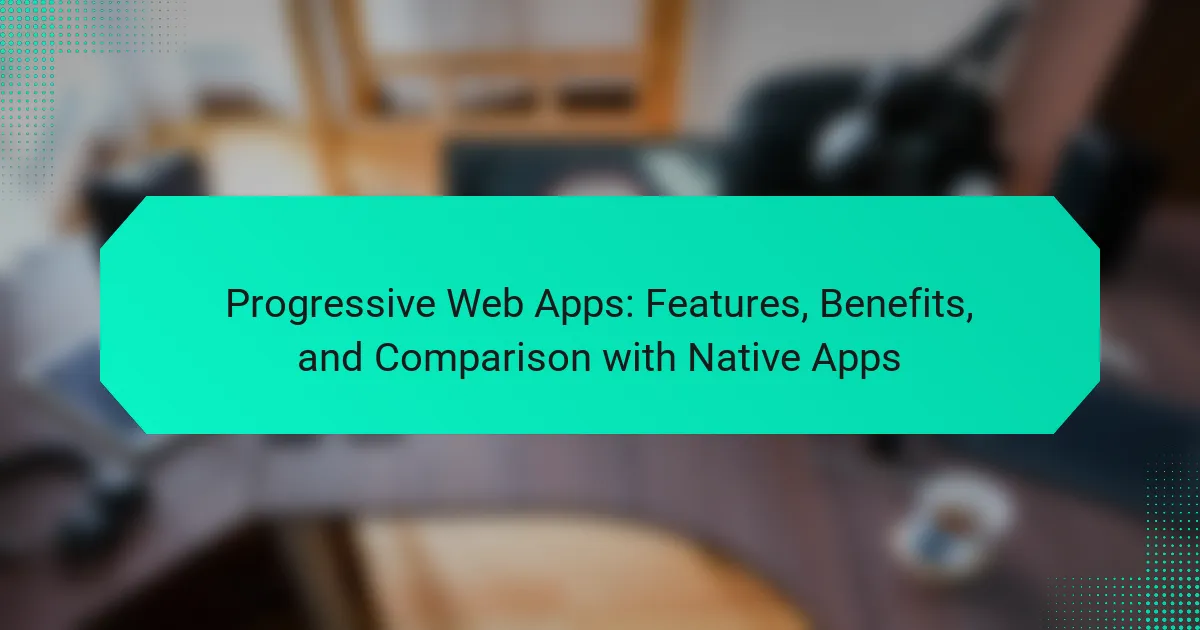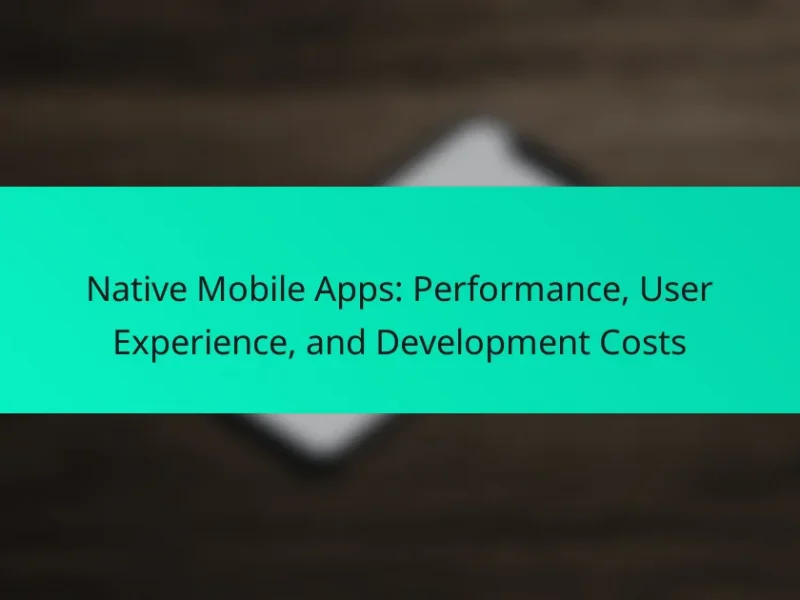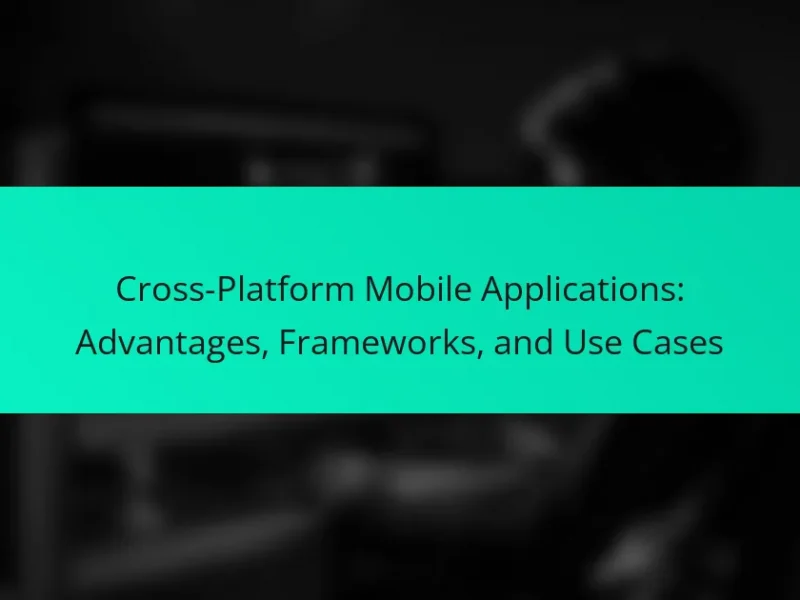Progressive Web Apps (PWAs) are web applications that utilize modern web technologies to provide an app-like experience across all devices with standards-compliant browsers. This article explores the key features and benefits of PWAs, including offline functionality, push notifications, and fast loading times, while comparing them to Native Apps, which are designed specifically for individual platforms like iOS or Android. Key considerations for developing PWAs, such as responsive design, performance optimization, and security, will also be discussed. Understanding these aspects helps businesses make informed decisions about enhancing user engagement and experience.
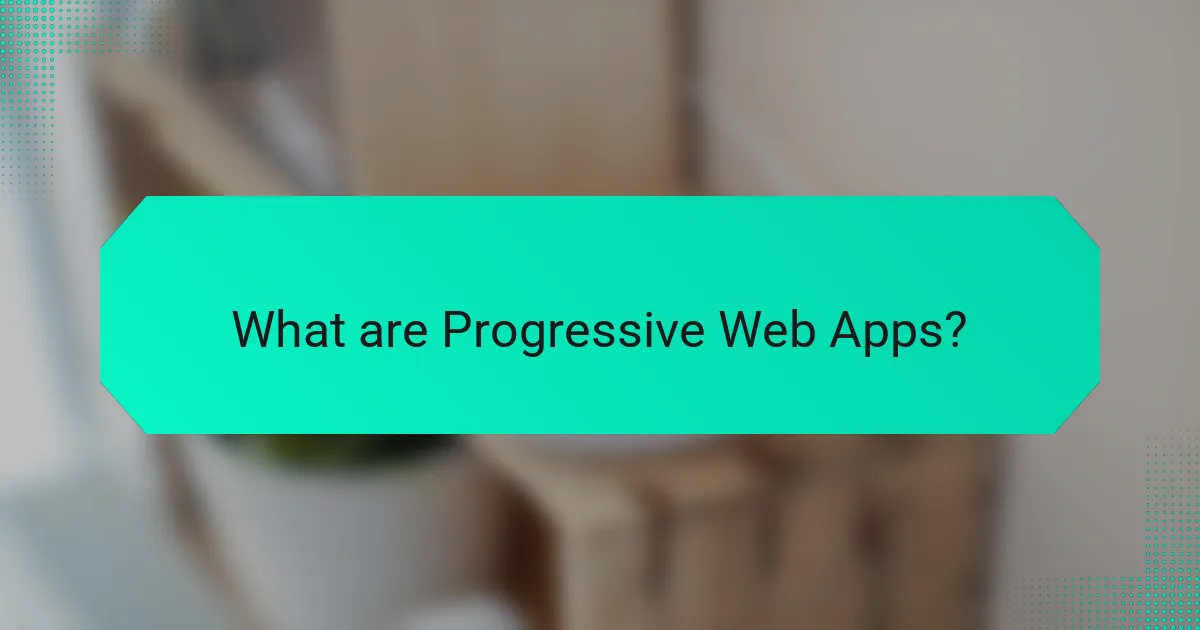
What are Progressive Web Apps?
Progressive Web Apps (PWAs) are web applications that use modern web capabilities to deliver an app-like experience. They combine the best features of web and mobile apps. PWAs are designed to work on any platform that uses a standards-compliant browser. They provide offline functionality, push notifications, and fast loading times. PWAs are built using standard web technologies like HTML, CSS, and JavaScript. They can be installed on a user’s device and accessed from the home screen. According to Google, PWAs can increase user engagement by up to 50%. This makes them a valuable option for businesses looking to enhance user experience.
How do Progressive Web Apps differ from traditional web applications?
Progressive Web Apps (PWAs) differ from traditional web applications in their ability to provide a native app-like experience. PWAs can work offline and utilize service workers for caching. Traditional web applications typically require a constant internet connection. PWAs can be installed on a user’s device, appearing on the home screen like native apps. Traditional web applications are accessed through a browser without installation. PWAs support push notifications, enhancing user engagement. Traditional web applications lack this capability. PWAs are designed to be responsive, adapting to various screen sizes seamlessly. Traditional web applications may not optimize for different devices as effectively.
What technologies enable the functionality of Progressive Web Apps?
Progressive Web Apps (PWAs) are enabled by several key technologies. These technologies include Service Workers, which allow background processes and offline capabilities. Another technology is the Web App Manifest, which provides metadata for the app. HTTPS is essential for secure connections, ensuring data integrity and security. Additionally, responsive design techniques enable PWAs to function on various devices and screen sizes. Finally, IndexedDB allows for efficient data storage and retrieval. These technologies collectively enhance user experience and functionality in PWAs.
What role do service workers play in Progressive Web Apps?
Service workers are essential components of Progressive Web Apps (PWAs). They act as intermediaries between the web application and the network. Service workers enable features like offline access and background syncing. They cache resources to improve loading times and enhance performance. This functionality allows PWAs to work seamlessly even without an internet connection. According to Google, service workers can handle push notifications, further engaging users. Their ability to intercept network requests also allows for fine-tuned control over data retrieval. Overall, service workers significantly enhance the user experience in PWAs.
What are the key features of Progressive Web Apps?
Progressive Web Apps (PWAs) have several key features. They are reliable, loading quickly even on flaky networks. PWAs are responsive, adapting to various screen sizes. They provide an app-like experience with smooth navigation and interactions. PWAs can be installed on the user’s device, creating a shortcut on the home screen. They work offline through service workers, enabling functionality without an internet connection. PWAs are secure, served over HTTPS to prevent man-in-the-middle attacks. They are discoverable via search engines, making them accessible. Finally, PWAs can send push notifications to engage users. These features collectively enhance user experience and accessibility.
How do Progressive Web Apps enhance user experience?
Progressive Web Apps (PWAs) enhance user experience by providing fast loading times and offline capabilities. They utilize service workers to cache resources, enabling quick access even without an internet connection. PWAs also offer a responsive design that adapts to various screen sizes, ensuring usability across devices.
Additionally, they support push notifications, keeping users engaged with timely updates. The app-like interface of PWAs improves navigation and interaction, resembling native applications. According to Google, PWAs can increase conversion rates by up to 36% due to their improved performance and user engagement features. Overall, PWAs combine the best of web and mobile app experiences, leading to higher user satisfaction.
What offline capabilities do Progressive Web Apps provide?
Progressive Web Apps (PWAs) provide several offline capabilities through service workers. Service workers enable caching of resources, allowing users to access content without an internet connection. They can store HTML, CSS, JavaScript, and images for offline use. This caching mechanism enhances user experience by loading content quickly. Additionally, PWAs can utilize IndexedDB for storing data locally. This allows users to interact with the app and save changes offline. When the device reconnects, the app can sync data with the server. This functionality makes PWAs reliable in low or no connectivity situations.
What benefits do Progressive Web Apps offer to businesses and users?
Progressive Web Apps (PWAs) offer significant benefits to both businesses and users. For businesses, PWAs enhance user engagement through faster load times and improved performance. They can work offline, which increases accessibility and user retention. Businesses can also save on development costs as PWAs eliminate the need for separate apps for different platforms. Additionally, PWAs can be easily updated without requiring users to download new versions.
For users, PWAs provide a seamless experience similar to native apps. They can be added to the home screen, allowing easy access. Users benefit from push notifications, which keep them informed and engaged. PWAs also consume less data compared to traditional apps, making them more efficient. Overall, the adoption of PWAs can lead to higher conversion rates and improved customer satisfaction.
How do Progressive Web Apps improve engagement and retention?
Progressive Web Apps (PWAs) improve engagement and retention through enhanced user experiences. They offer fast loading times, which keeps users interested and reduces bounce rates. PWAs utilize push notifications to re-engage users, prompting them to return to the app. They also provide offline access, ensuring users can interact even without an internet connection. According to Google, PWAs can increase user retention by up to 42% compared to traditional web apps. Their app-like interface improves usability, leading to higher satisfaction rates. Overall, these features contribute to a more compelling user experience, driving higher engagement and retention.
What cost savings can businesses expect from using Progressive Web Apps?
Businesses can expect significant cost savings from using Progressive Web Apps (PWAs). PWAs reduce development costs by allowing a single codebase to serve both web and mobile platforms. This eliminates the need for separate native app development. Additionally, PWAs require less maintenance compared to traditional apps. They do not need frequent updates through app stores, which saves time and resources.
Hosting costs are also lower, as PWAs can be served from standard web servers. The improved user experience leads to higher engagement and retention, translating to increased revenue without proportional increases in marketing spend. According to a study by Google, businesses can see up to a 50% reduction in development and maintenance costs with PWAs.
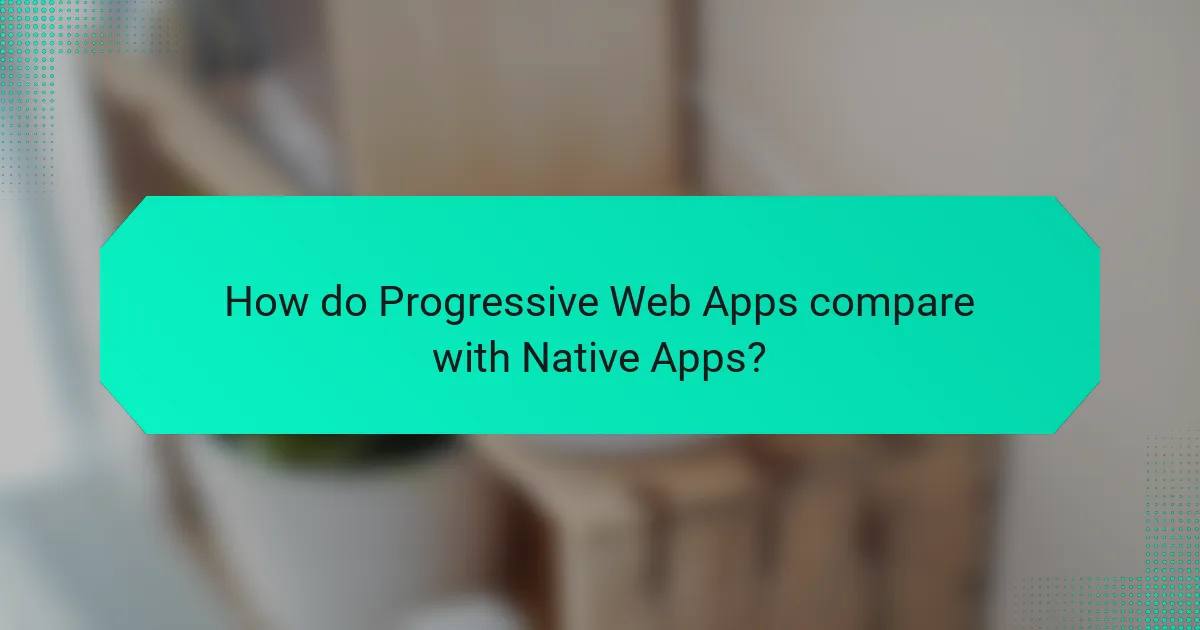
How do Progressive Web Apps compare with Native Apps?
Progressive Web Apps (PWAs) and Native Apps differ in several key aspects. PWAs are web applications that utilize modern web capabilities to deliver an app-like experience. Native Apps are developed specifically for a particular platform, such as iOS or Android.
PWAs are accessible through web browsers and do not require installation from app stores. Native Apps must be downloaded and installed from app stores, impacting user accessibility. PWAs can be updated instantly without user intervention. Native Apps require users to download updates manually.
Performance-wise, Native Apps generally provide better speed and responsiveness. They can leverage device hardware more efficiently than PWAs. However, PWAs offer cross-platform compatibility, functioning on any device with a web browser. Native Apps are platform-specific, often requiring separate codebases for different systems.
In terms of development cost, PWAs are typically less expensive to create and maintain. Native Apps often require more resources due to the need for multiple versions. User engagement can be higher for Native Apps, as they can utilize push notifications more effectively.
Overall, the choice between PWAs and Native Apps depends on specific business needs and user experience goals. Each has its unique strengths and weaknesses that cater to different requirements.
What are the main differences between Progressive Web Apps and Native Apps?
Progressive Web Apps (PWAs) and Native Apps differ primarily in their development and functionality. PWAs are web applications that can be accessed via a browser and do not require installation. They utilize web technologies like HTML, CSS, and JavaScript. In contrast, Native Apps are developed specifically for a particular platform, such as iOS or Android, and must be downloaded from app stores.
PWAs offer offline capabilities through service workers, while Native Apps can access device hardware like cameras and GPS more directly. PWAs are generally easier to update since changes are made on the server side. Native Apps often provide a more optimized user experience tailored to the operating system.
According to a 2021 report by Google, PWAs can load 2-3 times faster than traditional web apps, enhancing user engagement. Native Apps tend to have higher performance due to direct access to device resources. Each has its advantages, making the choice dependent on specific use cases and user needs.
How do installation processes differ for Progressive Web Apps and Native Apps?
Progressive Web Apps (PWAs) and Native Apps have distinct installation processes. PWAs can be installed directly from a web browser without needing an app store. Users simply visit the website and can add the app to their home screen. This process is quick and does not require extensive permissions.
In contrast, Native Apps require downloading from an app store, such as the Apple App Store or Google Play Store. This process involves multiple steps, including searching for the app, downloading it, and granting various permissions.
Additionally, Native Apps often need updates through the app store, while PWAs can update automatically in the background. This difference in installation and update processes highlights the flexibility of PWAs compared to the more traditional method of Native Apps.
What performance differences can users expect between Progressive Web Apps and Native Apps?
Progressive Web Apps (PWAs) generally offer slower performance compared to Native Apps. PWAs rely on web technologies and may experience latency due to network dependency. Native Apps, built for specific platforms, utilize device capabilities directly, resulting in faster load times and smoother user experiences. According to a study by Google, Native Apps can load up to 2-3 times faster than PWAs in certain scenarios. Additionally, Native Apps provide better access to system resources, enhancing performance for graphics-intensive applications. In contrast, PWAs may struggle with high-performance tasks due to their reliance on browser capabilities. Overall, users can expect Native Apps to deliver superior performance, particularly in resource-heavy applications.
What are the advantages of using Progressive Web Apps over Native Apps?
Progressive Web Apps (PWAs) offer several advantages over Native Apps. First, PWAs are accessible through a web browser, eliminating the need for installation. This leads to faster user engagement. Second, they provide cross-platform compatibility, functioning on various devices and operating systems. This reduces development costs and time. Third, PWAs can work offline, utilizing service workers to cache content. This ensures functionality even without internet access. Fourth, they have automatic updates, which means users always access the latest version without manual downloads. Finally, PWAs consume less device storage compared to Native Apps, as they do not require large installations. These factors contribute to a more efficient and user-friendly experience.
How do updates and maintenance differ for Progressive Web Apps and Native Apps?
Updates and maintenance for Progressive Web Apps (PWAs) differ significantly from Native Apps. PWAs can be updated instantly on the server side without requiring user action. Users always access the latest version when they visit the PWA. In contrast, Native Apps require users to download updates through app stores. This process can lead to delays in users accessing new features or fixes.
Maintenance for PWAs is generally simpler. Developers can manage and deploy updates centrally. This reduces the complexity of maintaining multiple versions across different platforms. Native Apps often require separate maintenance for each operating system, increasing the workload for developers.
Additionally, PWAs can leverage service workers for background updates. This allows for seamless updates without interrupting the user experience. Native Apps do not have this capability and rely on the app store’s update process.
These differences highlight the efficiency and streamlined nature of updates and maintenance in PWAs compared to Native Apps.
What are the implications for cross-platform compatibility?
Cross-platform compatibility in Progressive Web Apps (PWAs) allows applications to function seamlessly across various devices and operating systems. This capability enhances user experience by providing consistent functionality, regardless of the platform. PWAs leverage web technologies like HTML, CSS, and JavaScript, which are inherently cross-compatible. According to a study by Google, PWAs can achieve up to 90% of the performance of native apps while maintaining a single codebase. This reduces development time and costs significantly, as developers do not need to create separate versions for different platforms. Additionally, cross-platform compatibility increases accessibility, allowing users to engage with applications on their preferred devices without limitations.

What considerations should be made when developing Progressive Web Apps?
When developing Progressive Web Apps (PWAs), several key considerations must be made. First, developers should focus on creating a responsive design. This ensures the app functions well on various devices and screen sizes. Second, performance optimization is crucial. Fast loading times enhance user experience and retention. Third, offline capabilities should be integrated. Service workers enable PWAs to function without an internet connection. Fourth, security is paramount. Implementing HTTPS protects user data and builds trust. Fifth, accessibility features must be included. This ensures the app is usable for all users, including those with disabilities. Lastly, testing across different browsers is essential. This guarantees compatibility and a consistent user experience. These considerations collectively contribute to the effectiveness and usability of PWAs.
What best practices should developers follow for Progressive Web Apps?
Developers should follow several best practices for Progressive Web Apps (PWAs). First, they must ensure the app is responsive and works on various devices. This adaptability enhances user experience across different screen sizes. Second, implementing a service worker is crucial. Service workers enable offline capabilities and caching for faster load times. Third, developers should prioritize performance optimization. Techniques like lazy loading and minimizing resource sizes improve app speed. Fourth, using HTTPS is essential for security. Secure connections protect user data and enhance trust. Fifth, developers should provide a manifest file. This file allows for home screen installation and custom icons. Lastly, regular testing across multiple browsers and devices is vital. Testing ensures compatibility and a smooth user experience.
How can developers ensure optimal performance for Progressive Web Apps?
Developers can ensure optimal performance for Progressive Web Apps (PWAs) by implementing various strategies. First, they should utilize service workers to enable offline capabilities and improve load times. Service workers cache resources, allowing for faster access and reduced server load.
Second, developers should optimize assets by compressing images and minifying CSS and JavaScript files. This reduces the overall size of the application, resulting in quicker downloads.
Third, implementing lazy loading for images and other non-critical resources can enhance performance. This technique loads only the necessary elements initially, improving the initial load speed.
Additionally, developers should prioritize responsive design to ensure PWAs perform well across different devices and screen sizes. Responsive design adapts the layout based on the user’s device, enhancing user experience.
Finally, regular performance audits using tools like Lighthouse can help identify bottlenecks and areas for improvement. These audits provide insights into loading performance, accessibility, and best practices, enabling developers to make informed adjustments.
What tools can assist in the development of Progressive Web Apps?
Tools that assist in the development of Progressive Web Apps include frameworks, libraries, and development environments. Popular frameworks are Angular, React, and Vue.js. These frameworks provide essential components for building responsive interfaces. Libraries like Workbox help manage service workers for offline capabilities. Development environments such as Visual Studio Code offer useful extensions for PWA development. Tools like Lighthouse are vital for performance audits and best practices. Additionally, Firebase provides backend services and hosting solutions tailored for PWAs. These tools collectively streamline the development process and enhance app functionality.
What common challenges do developers face with Progressive Web Apps?
Developers face several common challenges with Progressive Web Apps (PWAs). One major challenge is browser compatibility. Not all browsers fully support PWA features, leading to inconsistent user experiences. Another challenge is service worker implementation. Developers often struggle with caching strategies, which can affect performance and reliability.
Additionally, push notifications can be problematic. Not all users opt-in, limiting engagement potential. Network reliability is another concern. PWAs rely on internet connectivity, which can hinder functionality in offline scenarios.
Finally, performance optimization remains a challenge. Developers must balance resource usage to ensure smooth operation across devices. These challenges highlight the complexities involved in developing effective PWAs.
How can developers address issues related to browser compatibility?
Developers can address issues related to browser compatibility by using feature detection. This method allows developers to check if a specific feature is supported in the user’s browser. Tools like Modernizr help automate this process. Additionally, developers can implement polyfills to provide fallback solutions for unsupported features. Cross-browser testing tools, such as BrowserStack, enable testing on various browsers and devices. Responsive design techniques ensure that web apps adapt to different screen sizes and resolutions. Adhering to web standards set by the World Wide Web Consortium (W3C) promotes compatibility. Regularly updating code and libraries helps mitigate compatibility issues as browsers evolve.
What strategies can be implemented to enhance security in Progressive Web Apps?
Implementing strategies to enhance security in Progressive Web Apps (PWAs) includes using HTTPS, implementing service workers, and enforcing Content Security Policy (CSP). HTTPS encrypts data between the user and the server, protecting sensitive information. Service workers enable offline capabilities and can also manage network requests securely. CSP helps prevent cross-site scripting (XSS) attacks by controlling which resources can be loaded. Additionally, regular security audits and vulnerability assessments are crucial for identifying and mitigating risks. Implementing these strategies can significantly reduce the likelihood of security breaches in PWAs.
What are practical tips for users to maximize their experience with Progressive Web Apps?
To maximize the experience with Progressive Web Apps (PWAs), users should ensure they have a stable internet connection. A reliable connection enhances loading times and overall performance. Users should also add PWAs to their home screen for easier access. This allows for quick launching without navigating through a browser.
Enabling notifications can keep users updated with real-time alerts. This feature enhances engagement and usability. Users should also explore offline capabilities by using PWAs in areas with limited connectivity. Many PWAs offer offline access to previously loaded content.
Regularly clearing the browser cache can improve performance. This action removes outdated files that may slow down the app. Users should also check for updates to take advantage of new features and improvements. PWAs are designed to update automatically, but manual checks can ensure the latest version is in use.
Lastly, providing feedback to developers can help improve PWAs. Constructive feedback can lead to updates that enhance user experience.
Progressive Web Apps (PWAs) are web applications designed to provide an app-like experience by leveraging modern web capabilities. This article covers the key features of PWAs, such as offline functionality, push notifications, and fast loading times, as well as their advantages over traditional web applications and native apps. It also discusses the technologies that enable PWAs, including service workers and responsive design, and highlights the benefits for both users and businesses, such as improved engagement and cost savings. Additionally, the article addresses the challenges developers face and offers best practices for optimizing performance and security in PWAs.
